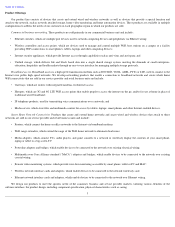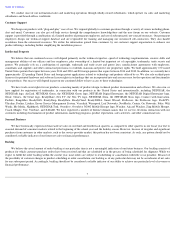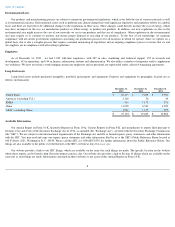Netgear 2013 Annual Report Download - page 16
Download and view the complete annual report
Please find page 16 of the 2013 Netgear annual report below. You can navigate through the pages in the report by either clicking on the pages listed below, or by using the keyword search tool below to find specific information within the annual report.
Table of Contents
If we fail to continue to introduce or acquire new products that achieve broad market acceptance on a timely basis, we will not be able to
compete effectively and we will be unable to increase or maintain net revenue and gross margins.
We operate in a highly competitive, quickly changing environment, and our future success depends on our ability to develop or acquire, and
introduce new products that achieve broad market acceptance. Our future success will depend in large part upon our ability to identify demand trends in
the commercial business, retail, and service provider markets and quickly develop or acquire, and manufacture and sell products that satisfy these
demands in a cost effective manner. In order to differentiate our products from our competitors' products, we must continue to increase our focus and
capital investment in research and development, including software development. Successfully predicting demand trends is difficult, and it is very
difficult to predict the effect introducing a new product will have on existing product sales. We will also need to respond effectively to new product
announcements by our competitors by quickly introducing competitive products.
We recently developed and launched new products worldwide under a new brand as an effort to increase sales in a particular market segment. The
new brand products may adversely affect sales of our existing products. Marketing of the new brand may also lead to confusion with our existing
customers. We have little to no experience in selling a new brand simultaneously with our existing product portfolio. If we are unable to effectively
manage the pricing, marketing, sale and distribution of products under our new brand together with our existing products, our business will be harmed.
In addition, we have acquired companies and technologies in the past and as a result, have introduced new product lines in new markets. We may
not be able to successfully manage integration of the new product lines with our existing products. Selling new product lines in new markets will require
our management to learn different strategies in order to be successful. We may be unsuccessful in launching a newly acquired product line in new
markets which requires management of new suppliers, potential new customers and new business models. Our management may not have the experience
of selling in these new markets and we may not be able to grow our business as planned. For example, our recent acquisition of the VueZone product
line continues to require significant management effort to successfully scale and launch the products worldwide. Similarly, in April 2013, we completed
the acquisition of the AirCard product line from Sierra Wireless. If we are unable to effectively and successfully integrate these new product lines, we
may not be able to increase or maintain our sales and our gross margins may be adversely affected.
We have experienced delays and quality issues in releasing new products in the past, which resulted in lower quarterly net revenue than expected.
In addition, we have experienced, and may in the future experience, product introductions that fall short of our projected rates of market adoption.
Online Internet reviews of our products are increasingly becoming a significant factor in the success of our new product launches, especially in the retail
business unit. If we are unable to quickly respond to negative reviews, including end user reviews posted on various prominent online retailers, our
ability to sell these products will be harmed. Any future delays in product development and introduction, or product introductions that do not meet broad
market acceptance, or unsuccessful launches of newly acquired product lines could result in:
Throughout the past couple of years, we have significantly increased the rate of our new product introductions. If we cannot sustain that pace of
product introductions, either through rapid innovation or acquisition of new products or product lines, we may not be able to maintain or increase the
market share of our products. In addition, if we are unable to successfully introduce or acquire new products with higher gross margins, our net revenue
and overall gross margin would likely decline.
Some of our competitors have substantially greater resources than we do, and to be competitive we may be required to lower our prices or
increase our sales and marketing expenses, which could result in reduced margins and loss of market share.
We compete in a rapidly evolving and fiercely competitive market, and we expect competition to continue to be intense, including price
competition. Our principal competitors in the commercial business market include Allied Telesys, Barracuda, Buffalo, Data Robotics, Dell, D-
Link,
Fortinet, Hewlett-Packard, Huawei, Cisco Systems, the Linksys line of products under
13
•
loss of or delay in revenue and loss of market share;
•
negative publicity and damage to our reputation and brand;
•
a decline in the average selling price of our products;
•
adverse reactions in our sales channels, such as reduced shelf space, reduced online product visibility, or loss of sales channel; and
•
increased levels of product returns.
























